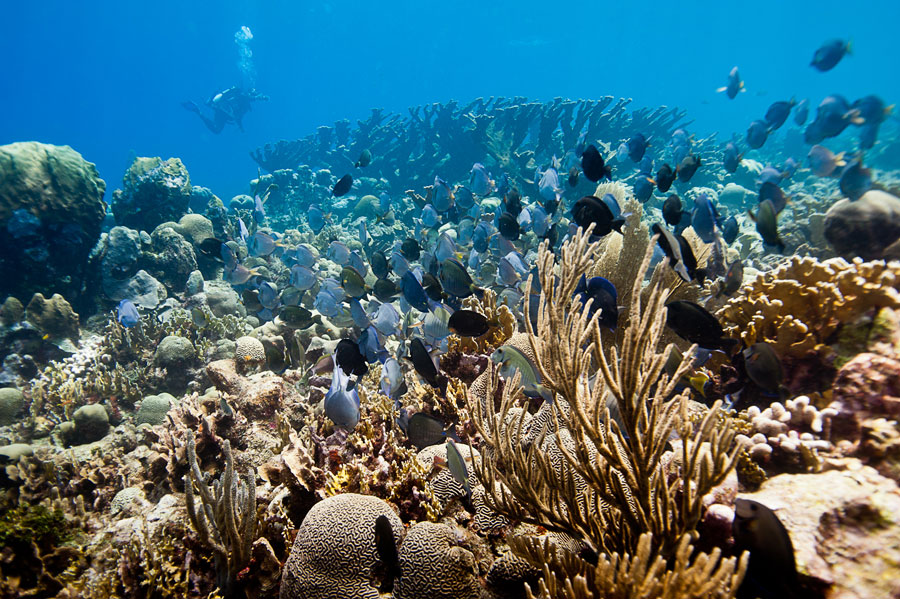The Mesoamerican Barrier Reef (also known as The Great Mayan Reef) is called the “Jewel of the Caribbean.” This huge reef is situated in the Caribbean Sea and extends along the coasts of Honduras, Belize, Guatemala, and Mexico. The Mesoamerican Barrier Reef is the longest reef in the Western Hemisphere, stretching from the northern tip of the Yucatan Peninsula to the Honduras Bay Islands. It stretches over 600 miles long.
The reef system boasts some 65 species of stony coral and over 1,000 species of fish, many of which are endangered.

Amazing Coral Variety
The Mesoamerican Reef is comprised of all kinds of coral reef formations. There are barrier reefs, fringe reefs, patch reefs, and coral atolls here, as well as lagoons and billions of mangrove trees.

Amazing Fishes, Turtles, and Fun Manatees
If you want to see the highly amusing, fascinating manatees, the MesoAmerican Reef is the place for you. The MesoAmerican Barrier Reef is home to some 1,500 manatees. In fact, this reef has the largest population of manatees in the world.
This reef system is also home to many endangered species of fish including the Queen Conch and Splendid Toadfish. Many protected or endangered species of sea turtles such as the loggerhead turtle, leatherback turtle, green turtle, and the hawksbill turtle all float in the seas here.
The reef also boasts the largest species of fish and shark in the world, the whale shark. There are some 1,000 species of fish here that have been documented so far.
Several species of dolphins swim in the Mesoamerican Reef’s waters including the spotted dolphin, rough-toothed dolphin, and bottlenose dolphin. Endangered crocodiles are found in some parts of the coast, especially in cays. Commercially exploited species of fish here include shrimp, grouper, snapper, spiny lobster, and queen conch.
One of the most interesting fish that calls this reef home is the parrot fish. This fish so closely resembles a macaw that it is somewhat alarming. Its fins resemble the colorful wings on the bird as well as its colorful snout, resembling a beak.
Threats to the MesoAmerican Reef
Storms, hurricanes, and tropical storms take their toll on these reefs as well, but it is humans that pose the biggest threat to the MesoAmerican Reef.
The MesoAmerican reef is beginning to show strong signs of coral bleaching due to human-caused climate change. The corals here cannot survive the changing of the temperatures that come with global warming. The problem is so severe that communities are partnering with the World Wide Fund for Nature to develop climate adaptation strategies that will help these reefs survive.
Overfishing, coastal development, and pollution also threaten these reefs. In fact, scholars say that humans, not nature, are specifically to blame for the alarming decline of this beautiful reef.
The Necessity of Mangroves
What protects the MesoAmerican reefs more than humans can are the mangrove trees here. These mangrove trees form in huge lines that are like soldiers ready for a battle. Sometimes three or four lines of mangroves protect these waters. The lines form into linear archipelagos that protect these reefs from silt, pollution, runoff, fertilizers, and other toxins.
These trees also provide these reefs with another highly necessary element—mulch. The leaves of these trees fall, decay, and provide food bacteria and small worms, which become the basis of a delicate ecosystem that feeds all of the small and larger fish that the smaller fish become food for.
Destruction of these lines of mangroves would destroy this balanced ecosystem – but scientists predict that mangroves will continue to be threatened by human development, which is destroying the mangroves at an alarming rate. Communities want tourism dollars, of course, and are building hotels and businesses that will attract more of them. But the construction and its runoff are destroying the very thing that tourists come to see.
Stop Taking the Parrotfish: This Reef Needs Them To Live!

Balanced ecosystems are so important for the health of coral reefs. For example, when fishermen keep fishing for parrotfish, for example, which are very prized, they upset the entire ecosystem, threatening the life of these coral reefs. Those parrotfish are very necessary parts of the reef’s delicate ecosystem, since they eat away the more damaging forms of microalgae that cover the reefs, keeping this algae from taking over the reef, weakening it and making it vulnerable to disease.
